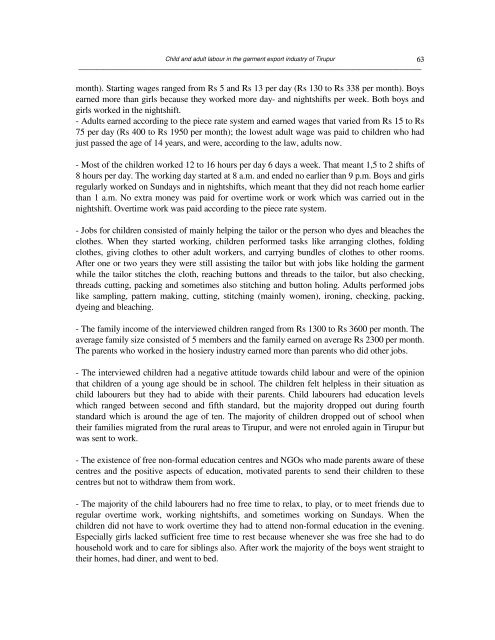You also want an ePaper? Increase the reach of your titles
YUMPU automatically turns print PDFs into web optimized ePapers that Google loves.
<strong>Child</strong> <strong>and</strong> <strong>adult</strong> <strong>labour</strong> <strong>in</strong> <strong>the</strong> <strong>garment</strong> <strong>export</strong> <strong>in</strong>dustry <strong>of</strong> Tirupur<br />
──────────────────────────────────────────────────────────────────────────────────────────────<br />
month). Start<strong>in</strong>g wages ranged from Rs 5 <strong>and</strong> Rs 13 per day (Rs 130 to Rs 338 per month). Boys<br />
earned more than girls because <strong>the</strong>y worked more day- <strong>and</strong> nightshifts per week. Both boys <strong>and</strong><br />
girls worked <strong>in</strong> <strong>the</strong> nightshift.<br />
- Adults earned accord<strong>in</strong>g to <strong>the</strong> piece rate system <strong>and</strong> earned wages that varied from Rs 15 to Rs<br />
75 per day (Rs 400 to Rs 1950 per month); <strong>the</strong> lowest <strong>adult</strong> wage was paid to children who had<br />
just passed <strong>the</strong> age <strong>of</strong> 14 years, <strong>and</strong> were, accord<strong>in</strong>g to <strong>the</strong> law, <strong>adult</strong>s now.<br />
- Most <strong>of</strong> <strong>the</strong> children worked 12 to 16 hours per day 6 days a week. That meant 1,5 to 2 shifts <strong>of</strong><br />
8 hours per day. The work<strong>in</strong>g day started at 8 a.m. <strong>and</strong> ended no earlier than 9 p.m. Boys <strong>and</strong> girls<br />
regularly worked on Sundays <strong>and</strong> <strong>in</strong> nightshifts, which meant that <strong>the</strong>y did not reach home earlier<br />
than 1 a.m. No extra money was paid for overtime work or work which was carried out <strong>in</strong> <strong>the</strong><br />
nightshift. Overtime work was paid accord<strong>in</strong>g to <strong>the</strong> piece rate system.<br />
- Jobs for children consisted <strong>of</strong> ma<strong>in</strong>ly help<strong>in</strong>g <strong>the</strong> tailor or <strong>the</strong> person who dyes <strong>and</strong> bleaches <strong>the</strong><br />
clo<strong>the</strong>s. When <strong>the</strong>y started work<strong>in</strong>g, children performed tasks like arrang<strong>in</strong>g clo<strong>the</strong>s, fold<strong>in</strong>g<br />
clo<strong>the</strong>s, giv<strong>in</strong>g clo<strong>the</strong>s to o<strong>the</strong>r <strong>adult</strong> workers, <strong>and</strong> carry<strong>in</strong>g bundles <strong>of</strong> clo<strong>the</strong>s to o<strong>the</strong>r rooms.<br />
After one or two years <strong>the</strong>y were still assist<strong>in</strong>g <strong>the</strong> tailor but with jobs like hold<strong>in</strong>g <strong>the</strong> <strong>garment</strong><br />
while <strong>the</strong> tailor stitches <strong>the</strong> cloth, reach<strong>in</strong>g buttons <strong>and</strong> threads to <strong>the</strong> tailor, but also check<strong>in</strong>g,<br />
threads cutt<strong>in</strong>g, pack<strong>in</strong>g <strong>and</strong> sometimes also stitch<strong>in</strong>g <strong>and</strong> button hol<strong>in</strong>g. Adults performed jobs<br />
like sampl<strong>in</strong>g, pattern mak<strong>in</strong>g, cutt<strong>in</strong>g, stitch<strong>in</strong>g (ma<strong>in</strong>ly women), iron<strong>in</strong>g, check<strong>in</strong>g, pack<strong>in</strong>g,<br />
dye<strong>in</strong>g <strong>and</strong> bleach<strong>in</strong>g.<br />
- The family <strong>in</strong>come <strong>of</strong> <strong>the</strong> <strong>in</strong>terviewed children ranged from Rs 1300 to Rs 3600 per month. The<br />
average family size consisted <strong>of</strong> 5 members <strong>and</strong> <strong>the</strong> family earned on average Rs 2300 per month.<br />
The parents who worked <strong>in</strong> <strong>the</strong> hosiery <strong>in</strong>dustry earned more than parents who did o<strong>the</strong>r jobs.<br />
- The <strong>in</strong>terviewed children had a negative attitude towards child <strong>labour</strong> <strong>and</strong> were <strong>of</strong> <strong>the</strong> op<strong>in</strong>ion<br />
that children <strong>of</strong> a young age should be <strong>in</strong> school. The children felt helpless <strong>in</strong> <strong>the</strong>ir situation as<br />
child <strong>labour</strong>ers but <strong>the</strong>y had to abide with <strong>the</strong>ir parents. <strong>Child</strong> <strong>labour</strong>ers had education levels<br />
which ranged between second <strong>and</strong> fifth st<strong>and</strong>ard, but <strong>the</strong> majority dropped out dur<strong>in</strong>g fourth<br />
st<strong>and</strong>ard which is around <strong>the</strong> age <strong>of</strong> ten. The majority <strong>of</strong> children dropped out <strong>of</strong> school when<br />
<strong>the</strong>ir families migrated from <strong>the</strong> rural areas to Tirupur, <strong>and</strong> were not enroled aga<strong>in</strong> <strong>in</strong> Tirupur but<br />
was sent to work.<br />
- The existence <strong>of</strong> free non-formal education centres <strong>and</strong> NGOs who made parents aware <strong>of</strong> <strong>the</strong>se<br />
centres <strong>and</strong> <strong>the</strong> positive aspects <strong>of</strong> education, motivated parents to send <strong>the</strong>ir children to <strong>the</strong>se<br />
centres but not to withdraw <strong>the</strong>m from work.<br />
- The majority <strong>of</strong> <strong>the</strong> child <strong>labour</strong>ers had no free time to relax, to play, or to meet friends due to<br />
regular overtime work, work<strong>in</strong>g nightshifts, <strong>and</strong> sometimes work<strong>in</strong>g on Sundays. When <strong>the</strong><br />
children did not have to work overtime <strong>the</strong>y had to attend non-formal education <strong>in</strong> <strong>the</strong> even<strong>in</strong>g.<br />
Especially girls lacked sufficient free time to rest because whenever she was free she had to do<br />
household work <strong>and</strong> to care for sibl<strong>in</strong>gs also. After work <strong>the</strong> majority <strong>of</strong> <strong>the</strong> boys went straight to<br />
<strong>the</strong>ir homes, had d<strong>in</strong>er, <strong>and</strong> went to bed.<br />
63


















